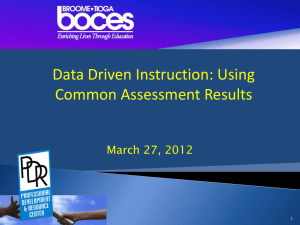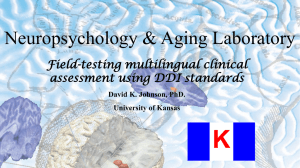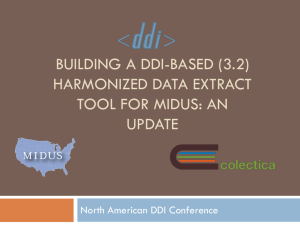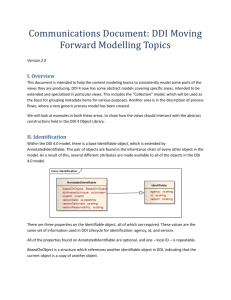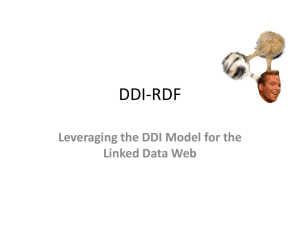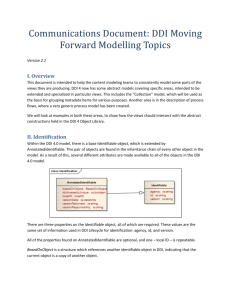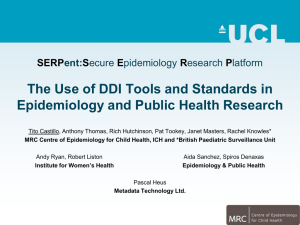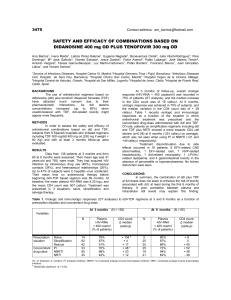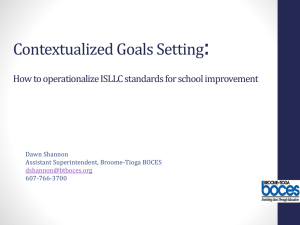Full powerpoint presentation - SFU's Institutional Repository
advertisement
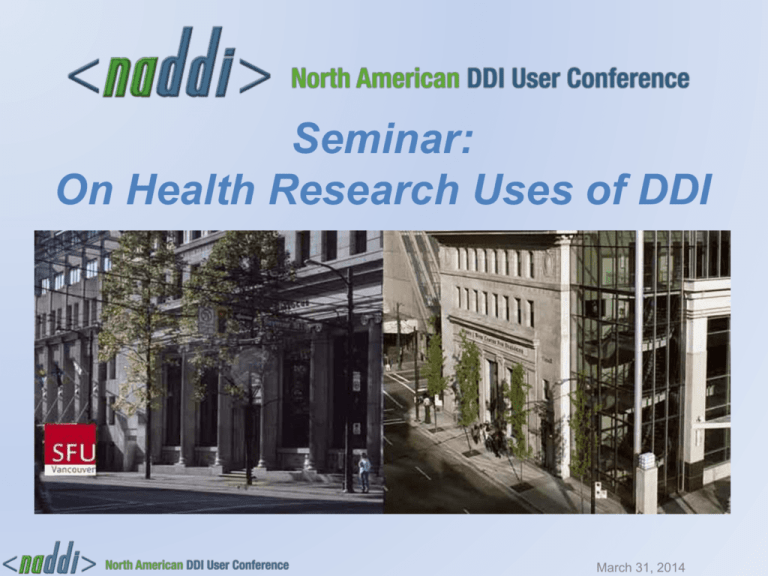
Seminar: On Health Research Uses of DDI March 31, 2014 Seminar: On Health Research Uses of DDI Barry T. Radler, PhD - MIDUS (University of Wisconsin Institute on Aging) David K. Johnson, PhD - CHARM (Kansas University Department of Psychology & Gerontology Center) March 31, 2014 March 31, 2014 Overview • Barry – Use of DDI in MIDUS • Accommodating non-survey measures • David –? • Discussion Points March 31, 2014 Background http://www.midus.wisc.edu/ March 31, 2014 MIDUS Guiding Conceptual Framework March 31, 2014 March 31, 2014 MIDUS Background • Multidisciplinary design – Aging as integrated bio-psycho-social process • Multiple waves (9-10 year interval) • Multiple samples/cohorts – – – – – 1 National (MIDUS Core) 2 Milwaukee 3 Japan (MIDJA) 4 National (MIDUS Refresher) 5 Milwaukee (Refresher) • Result – N=11,500 – 34,000 variables Guiding Principles of DDI use • Integrative, boundary-crossing studies – Facilitate multi-disciplinary research • Data sharing – Central to DDI: discoverability, use, replicability, management of data • Stakeholders: researchers • Practical uses of DDI • DDI non-questionnaire data capture March 31, 2014 Status of Current DDI Efforts Interuniversity Consortium for Political and Social Research www.icpsr.umich.edu MIDUS Metadata Repository: midus.colectica.org Describing MIDUS(non-survey) Health Meaures MIDUS(non-survey) Health Measures Biomarkers 1. Biomarkers reflecting the functioning of the hypothalamicpituitary-adrenal (HPA) axis, the autonomic nervous system, the immune system, cardiovascular system, musculoskeletal system, antioxidants, and metabolic processes. 2. Biological specimens (fasting blood draw, 12-hour urine, saliva – in Biomarker and Daily Stress projects). 3. Assessments by trained clinicians and staff of vital signs, morphology, functional capacities, bone densitometry, medication usage, a physical exam, heart-rate variability, beat to beat blood pressure, respiration, and salivary cortisol. 4. Self-reported sleep assessments and objective sleep assessments using an Actiwatch® activity monitor. Example: Clinical Exam March 31, 2014 Example: Tissue Samples March 31, 2014 Example: Gait Analysis March 31, 2014 Example: Psychophys Protocol March 31, 2014 Example: Sleep Assessment March 31, 2014 Example: Bone Density March 31, 2014 Example: Biomarker Processing & Transformations HDL-cholesterol adjustments • Serum is first mixed with synthetic polyanions, which adsorb to the surfaces of the other lipoproteins (LDL, VLDL, and chylomicrons); they are thereby transformed into detergent-resistant forms, whereas HDL is not. After solubilizing the HDL with detergent, it is measured as described above for total cholesterol. The HDL assay was re-standardized by Roche Diagnostics on August 6, 2007. The results of assays done after that date are adjusted, as follows, to bring the new values in line with the existing data: Adjusted value = 1.1423(new value) - 0.9028 March 31, 2014 Example: Biomarker Processing & Transformations M2 Biomarker Codebook March 31, 2014 MIDUS(non-survey) Health Measures Affective Neuroscience Examine the central circuitry associated with individual differences in : 1. Both emotional reactivity and emotional recovery using psychophysiological measures such as corrugator electromyography and eyeblink startle magnitude. 2. Brain morphology, in particular amygdala and hippocampal volume, using structural magnetic resonance imaging (MRI) 3. Activity within the neural circuitry of emotion regulation using both electroencephalography and fMRI Example: functional MRI March 31, 2014 Example: functional MRI IAPS pictures: 30 positive, 30 negative, and 30 neutral picture trials. 1 s 4s 2s 0.5 s ITI average of 7.5 s ITI range from 3.5-27.5 s 1 s Face “probes” 2 s after IAPS picture offset: 4s • 45 neutral, multiethnic, male and female faces • Each face is presented twice and paired with the same valence type of picture. • Participants identify the gender of the face via a responsepad. March 31, 2014 Example: EMG, EEG March 31, 2014 Example: EEG Processing & Transformations EEG recording • EEG activity was recorded using a 128-channel geodesic net of Ag/AgCl electrodes encased in saline-dampened sponges (Electrical Geodesics, Inc [EGI], Eugene, OR). Electrode impedances were reduced to less than 100 KΩ, and analog EEG signals were amplified and sampled at a rate of 500 Hz (band-pass filtered from 0.1-100 Hz) with 16-bit precision using an online vertex (Cz) reference. Example: EEG Processing & Transformations EEG data cleaning • After 60 Hz notch filtering and 0.5 Hz high-pass filtering to remove slow frequency drift, bad channels were identified and removed. Bad sections of data were also removed. Using EEGLAB6, the EEG data was then submitted to a PCA/ICA forcing the identification of 20 components. Components containing obvious eye blinks, eye movements, and other artifacts were then removed from the data. Bad channels were then replaced using a spherical spline interpolation. Epochs of 2 second length were then created. The EEGLAB automated artifact identification routine was then run on these epoched data files, identifying epochs containing deviations of ±100 microvolts, which were then subsequently removed. Example: EEG Processing & Transformations M2 Neuroscience Codebook March 31, 2014 How can DDI Document non-Questionnaire Data Capture? Rudimentary Example: ICPSR Version of M2P1 Codebook - Links March 31, 2014 http://www.ddialliance.org/resources/publications/working/BestPractices/LongitudinalData /DocumentingAWiderVarietyOfData-Final.pdf March 31, 2014 DDI 3.x Elements In Instrument, it is possible to provide information about the name of the instrument, a description of it, a type designation (which can come from a controlled vocabulary), information about any software tool that constitutes the instrument, and a reference to an external location (a URL at which the instrument resides, if applicable). In the CollectionEvent element, one can refer to the organization performing the data collection, describe its source, the date of the event, its frequency if repeated, the mode of the data collection, and the collection situation. ProcessingEvent permits the inclusion of a Coding, which contains a GenerationInstruction element. This allows one to specify many useful pieces of information. One can reference external information about the processing (e.g., the document quoted from MIDUS 2), provide a textual description of the processing as part of the DDI file, include specific commands used in the data collection, and include a description of the aggregation or scoring rules. The collMode (within dataColl) describes the method used to collect the data; instrumentation characteristics. March 31, 2014 DDI Markup: Biomarkers March 31, 2014 DDI Markup: Derived Scales March 31, 2014 DDI - The Future March 31, 2014 DDI - The Future: Other Standards Clinical Data Interchange Standards Consortium www.cdisc.org/standards-andimplementations Ontology for Biomedical Investigations bioportal.bioontology.org/ontologies/OBI March 31, 2014 DDI - The Future: SimpleInstrument March 31, 2014 DDI - The Future http://www.midus.wisc.edu/ Questions? March 31, 2014 Monday March 31st 2014 R21 TW009665 Epidemiology and the Development of Alzheimer’s Disease (EDAD) A Collaboration of the University of Kansas with the University of Costa Rica R21 TW009665 AD in Latin America • Low and middle income nations will experience an unprecedented growth of the elderly population and subsequent increase in agerelated neurological disorders • increased incidence (earlier detection/diagnosis becomes more available) • introduction of effective life extending technologies that yield increased duration of survival with disease. • Worldwide prevalence and incidence of Alzheimer’s disease will increase as life expectancy increases across the globe Why Costa Rica? • Nicoya Peninsula = Blue Zone (more older adults living 90+) • Equivalent Life Expectancy (CR=35th vs. US=33rd). • Hispanic Paradox: Rural older adult Costa Ricans live longer than we would expect given what we know (predict) about mortality • Popular culture of participation • Strong university connections for advanced training University of Costa Rica (UCR) & University of Kansas (KU) • Century long tradition of international academic exchange • Share over 30 academic training programs • Trained over 1000 exchange students. • By June 2011 centralized IT services at KU will support most of the UCR library and administrative services. • Both identified health sciences as the next shared initiative and the KU-UCR endowment fund awarded $25,000 development grants • Identify faculty and resources at UCR to extend the KU AMP’s research success to include Costa Rican clinical samples collected by UCR affiliates. KU Alzheimer Disease Center (P30 AG035982) Leader in the US for the study of exercise and metabolism on brain health and lifestyles that prevent Alzheimer’s disease • Trial for Exercise, Aging & Memory (TEAM; R01 AG034614) • Alzheimer Disease Exercise Program Trial (ADEPT; R01 AG033673) • KU Alzheimer Prevention Program (APP) • • • • Alzheimer Prevention through Exercise Program (APEX; R01 AG043962) Anti-Amyloid in Asymptomatic Amyloidosis (A4 ) Aspirin in Reducing Events in the Elderly (ASPREE) Trial Of Resistance Training for Increased AD Susceptibility (TORTIAS; KL2 TR000119) • Clinical Translational Science Award (FRONTIERS CTSA; UL1 TR000001) Cornerstones of prevention in AD and related chronic diseases •“Heart Healthy” lifestyle –Physical activity –Nutrition • Preventative medicine –Avoidance of preventable brain injury and disease –Management of heart disease, diabetes, depression, thyroid disease, etc. • Cognitive stimulation –Meaningful social engagement of our elders –Education builds greater cognitive reserve New research directions should include: • More sensitive diagnosis • Prospective study designs with hypotheses informed by epidemiological findings • Focus on public health • Developing new prevention technologies (behavioral, medical, digital) EDAD’s Scientific Aim Examine a mortality advantage found in Costa Rican epidemiological data that indicates lifestyle and environmental factors protect lower and low-middle class rural population sectors against age-related neurocognitive and physical decline. Hypothesis Lifestyle factors endemic to specific Costa Rican rural regions afford greater cardiovascular health which is the protective factor in healthy brain aging; between-group contrasts of urban versus rural CR elders will reveal significant moderating environmental factors of healthy versus unhealthy aging and that these environmental factors interact with measures of cardiovascular health. Prospective memory and aging pilot study • Step 1: Implement existing KU AMP protocols for neurocognitive, geriatric, and functional data in urban and rural based clinics. • Step 2: Recruit and assess 150 rural (blue zone) and 150 urban CR elders in the longitudinal epidemiological program (CRELES). • Step 3: Test group differences and develop risk stratification algorithm using multivariate logistic regression. • Step 4: Conduct multicultural comparison studies of clinical indices to determine sensitivity and specificity of common AD diagnostics and treatment indicators EDAD’s Aim to Build Infrastructure Extend the clinical research infrastructure of KU AMP to the University of Costa Rica and build its clinical research expertise for neurological diseases. • Step 1: Extend preexisting KU-UCR information technologies to underdeveloped Costa Rican clinical research centers; the IIP and CCP. KU will host data capture, management, and storage systems on the shared KU-UCR network system. • Step 2: Train existing faculty at UCR for clinical assessment and research methods in the assessment and treatment of neurological diseases in the developing world to support future clinical research in Costa Rica and across Central America. • Step 3: Create a baseline for a sustainable longitudinal study of Latin American aging and neurological diseases modeled on the KU Alzheimer and Memory Program. R21 TW009665 • To succeed harmonizing data collection across 5 different research programs taking place in 2 languages, we needed to create CHARM: • The Center for Hispanic American Research Methods (CHARM) is a cooperative of US and Latin American research laboratories interested in coordinating biobehavioral research. • CHARM relies on DDI and metadata standards to implement, collected, manage, and archive clinical research data Clinical Research Data Lifecycle KU Instrument Library (KUIL) • KUIL is a distributed research process • If the adoption of DDI is easy and committed to from beginning of many research studies then aggregating data reaches an economies of scale • KUIL is a large database of pre-formed items that are libraried (i.e., rationally stored using standard conventions) in a large assessment database that can be accessed and implemented in a user friendly interface • Designed to aid grassroot researchers to economically implement a sophisticated study using best-practice assessment. • Efficient • Collaborative • Because the heavy burden of adopting DDI at the start up is carried by the KUIL then that cost is distributed across many broad shoulders. • But Planning the interface becomes critical • Instrumentation needs vetting • Participation in item/instrument/method validation studies need to shared by all users - part of the user agreement Goal 1: • Create a multilingual applied clinical research library (to-date over 400 unique instruments in 850 different applications) that can be shared widely by investigators throughout the US and Latin America to facilitate high quality biobehavioral research on medical issues germane to Hispanic Americans. Goal 2: • Use data standards that specify a research lifecycle (the Data Documentation Initiative – version 3; DDI-3). By applying an international data standard to the clinical research instrument library, the CHARM offers participating investigators a database of welldescribed clinical instruments and code libraries that bootstrap the investigative process. • An investigator assembles a neurocognitive battery using a flexible assessment battery approach. The selected battery can be implemented using Computer Assisted Testing (CAT), REDCap (both online data entry or email surveys), LIME Survey and its associated Optical Character Recognition (OCR) software (QueXF), or more traditional Paper-and-Pencil via PDFs. • DDI standards create the database frame so that investigators move quickly to collect the data as well as offering open source tools to facilitate data entry and verification. Goal 3: • Provide a rational heuristic to pool data across sites, thus increasing power to detect meaningful differences while distributing the research costs, and subject burden. • So long as a cooperative of multi-site investigators used similar DDI standards (instrumentation, question phrasing and collection methods – all specified by the CHARM library) then those data can be pooled to answer a shared research question. • This framework promotes a coordinated, interdisciplinary approach to research while allaying some of the administrative burden of deploying a research project by an (usually) over-encumbered investigator. DDI Philosophy - Why focus on metadata? • Premium/costly datasets that contain valuable observations. • People • Tests • Labor to prep/process data • Outlines a rational plan to make data compatible (backward and forward in time) • Lots of work to bridge the divide across projects that worked in isolation • Taught a lesson for the forward looking planning to build comparability in to research projects from the start • Funding agencies now encourage research projects • coordinate with existing databases • use standardized measures • share data and data plans • Examples of heavy DDI users • Pan-European longitudinal studies • Harmonization of longitudinal datasets (e.g., NHANES & MIDUS) Phase 1: Training & Acculturating KU/UCR faculty • Clinical research methods • CHARM hosted 7 UCR faculty trainings over the last 5-years • Lawrence – Kansas City – San Jose – Liberia • KU dedicated graduate training in quantitative psychology for UCR candidates • New UCR Methods focus “Summer School” conducted every February • Alzheimer training and development • • • • Extended psychometric training in San Jose and Nicoya Penisula Autobiographical research program CRELES secondary data analysis for cognitive change and ADL Partnering with Memory Clinic at San Juan de Dios Hospital, San Jose Phase 2 Creating KU Instrument Library • July 2013: PI’s finalized battery used in EDAD research program • August 2013: PI’s researched and proofed an indexing system for clinical tests to be used in the field • September 2013: Two graduate students supervised a team of 4 research assistants to create the EDAD test library • October 2013: Data collected on 1st research participant in San Jose • November2013: Data collected on 1st research participant in Nicoya • Current: Over 400 unique instruments in 850 different applications Immediate targets of EDAD are also the initial targets for KUIL • Focus on collecting instruments related to: • • • • • Validated Bilingual Instruments Aging & Development Psycho-Social Assessment Cognition Physical fitness and health Phase 3: Colectica creates new features based on EDAD needs • Optical Character Recognition platform added to exportable output • Software written to input and manage multiple languages in item database • REDCap import/export capability finalized and copy of the KUIL is contributed to REDCap Shared Dat Instrument Library (SDIL) • Currently - KU and Colectica collaborate on refining DDI metadata to make it more robust for clinical and biobehavioral instrumentation Phase 4: Spanish Translation and Validation • Although we use validated and published translations wherever possible, there are many clinical instruments that still need translation by trained clinicians (about ⅔ of the library). • We are establishing an online referee process for these translations as well coordinating the translation assignments. • Plan to identify DDI and associated metadata to facilitate Mean And Covariance Structures (MACS) analysis of cross-cultural data • Increase the pace of cross cultural research • Efficiently validate cross-cultural instrumentation • Increase generalizability of translated instruments and items Seminar: On Health Research Uses of DDI Discussion Points March 31, 2014 Discussion Points • Challenges – Standardization • Procedures, measures, coding, • Ontologies (common language) • How to encourage adoption of standard! – Harmonization • Highlighting, resolving, ameliorating differences – Good data management practices • Proactive, not reactive, approach • Citing, replication, sharing, tenure March 31, 2014 Discussion Points • Challenges (cont’d) – Special collections • MRI imaging, size, special software – Cross-cultural, language • CHARM • MIDJA-MIDUS – Funding/resources March 31, 2014
